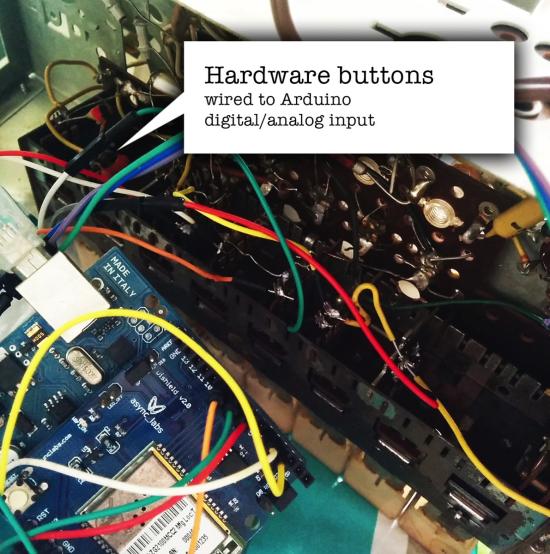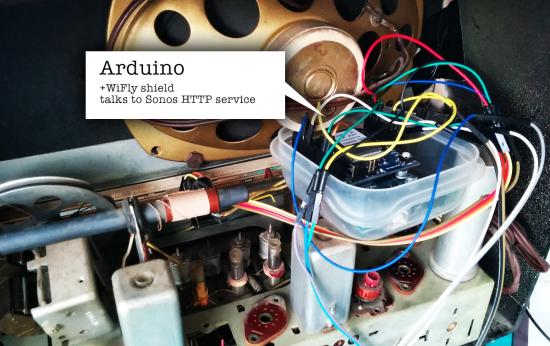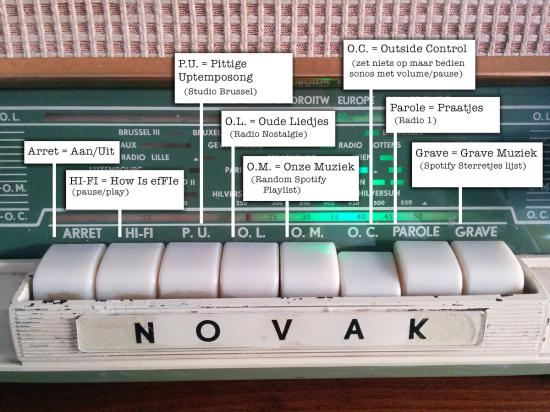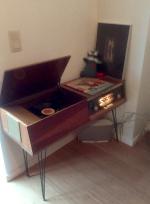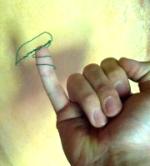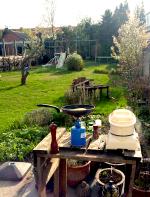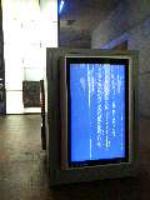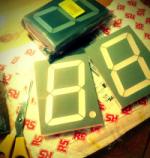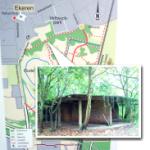The bigger plan of my Amiga-Javascript projects
The past years I have been slowly tinkering on various Amiga Projects.
Mostly in JavaScript, mostly to unlock various parts of the huge Amiga ecosystem: parsing ancient filesystems and fileformats, reading and writing Amiga files with new tools, ...
Slowly all these various tidbits are coming together in the big plan: to break the Amiga out of it's emulated container and to seamlessly integrate in a modern OS.
That modern OS is platform independent. It runs on everything and it is accessible from everywhere.
For me, this translated to an OS that is web based. It runs in your browser and it lives in the cloud.
There have been many approaches to such an OS, some of them - like FriendUP - clearly have their roots in the Amiga system.
One of the most interesting ones is Amibian.js. It's also inspired by the Amiga and it runs in javaScript: Node.js on the backend, browser in front.
I've been talking with Jon - the creator of Amibian.js.
It's a HUGELY ambitious project, ranging from custom compilers in various programming languages to a recreation of an Amiga-like OS, complete with compatible system library calls and more.
When doing a modern Amiga inspired OS, one of the big questions is how you handle legacy software.
The Amiga has an old but super mature ecosystem of programs but sadly all that software doesn't run anymore on modern systems.
The solution is to emulate that old hardware so you can still run all that old software.
The most used Amiga Emulator is WinUAE, a glorious and ultra-advanced piece of code.
Rupert Hausberger did the daunting task of porting it to javascript.
The drawback of emulating an Amiga is that it is a contained black-box system that has no knowledge of the larger system it's running on. WinUAE handles this quite elegantly by allowing a shared filesystem, but in your browser there's no such thing.
This is where I stepped in: an emulated boxed Amiga running in your browser is cool, but wouldn't it be even cooler to break it open?
You could use Amiga software to seamless edit/play your local files,
or launch modern non-Amiga tools from within the Amiga,
or compile a program for Amiga with today's tools and launch it directly on an emulated 68k CPU
or ....
All this directly available on whatever system you use and wherever you are.
In the end, the underlying technicalities shouldn't matter.
It shouldn't matter what OS a program was written for, or where your files are exactly, or even who's physical machine you are using. Just launch your space and mold it to your liking.
Amibian.js already tries to break the barriers between the browser and your local system.
Browser or native? It shouldn't matter.
I will gladly help and try to break the barriers between the emulated environments and the native ones:
Emulated or native? It shouldn't matter.
The top video is a first demo of the progress. It shows various aspects of building such a system.
Most notably a shared filesytem so both systems (emulated and native) can access the same files.
Everything you see is running in the browser.
The (emulated) Amiga is on the right, the host system is on the left.
We're still doing babysteps: trying out stuff and laying the foundation for the bigger plan.
The concept is always the same: a seamless integration where it doesn't matter anymore where your files are or on what platform your program is running on.
Tags: Commodore Amiga, in English, Programming, Scripting, TinkeringGeef je reactie (0)Bassoontracker - Release 0.3.0 is out!
During the past months I have been tinkering along on Bassoontracker - My browser based Retro Music Tool.
Today, it's ready for a next big release: Version 0.3.0 is out!
The most important feature is full FastTracker 2 compatibility. Yeah baby!
Fasttracker II was a music creation tool for DOS, released back in 1994 and it became THE standard for a long time for tracker based music.
1994 was also the year that Commodore went belly up, pulling the Amiga with them, so a lot of Amiga musicians made the jump to PC around that time, finding Fasttracker 2 as a perfect successor to Protracker.
Fasttracker is quite a bit more complex then a simple "sequencer". It added proper "Attack Decay Sustain Release" to instruments making them sound far more natural and supported 16 bit samples, a huge step up in quality.
Up to 32 channels are supported, 128 instruments, 2 concurrent channel effects and much much more ...
That was fun to implement!
Other big changes are:
- Dropbox integration: Load and save files directly from/to your Dropbox
- Enhanced Sample editor: Slice and transform your samples directly inside BassoonTracker
- Enhanced Pattern editing: use ranges and cut/copy/paste for quick editing
- Export your song to .wav or .mp3
- LOTS of fancy UI updates
And all that still in plain old javascript with ZERO dependencies.
During the years many thousands of music tracks have been made and you can access them all through the build-in Modarchive and Modules.pl browsers. (Which now have been expanded to include FastTracker .xm files too)
The playback engine has gone through extensive compatibility testing but if you find a module that doesn't sound the way it should: drop me line.
More info and full source code on Github:
Or check out the live demo on https://www.stef.be/bassoontracker/
Amiga CD32 Workbench Skin in 16 colors
So .. after 25 year there's a new update for the Classic Amiga Operating System.
yes, that's right: TWENTYFIVE YEARS after AmigaOS 3.1, there's now Amiga OS 3.1.4
That's nothing less then a small miracle.
25 years in computer land is like 12 gazillion years in normal time.
Recently there a big revival for Amiga computers with a lot of very interessing projects being done by enthusiasts - new software - new hardware ... the works!
The 'Official companies" are still plotting along - if they take a short break from suing each other, that is - but the most interesting ones are pure community projects, created out of pure love for the platform.
A VERY interesting one is the Terrible Fire 328 : an expansion card for the CD32 with extra ram, video out and an IDE interface, usually used to attach a bootable CF card.
Long story short: the TF328 transforms the CD32 in the coolest of all Amiga's.
But .... that new Workbench 3.1.4 still looks a little dull.
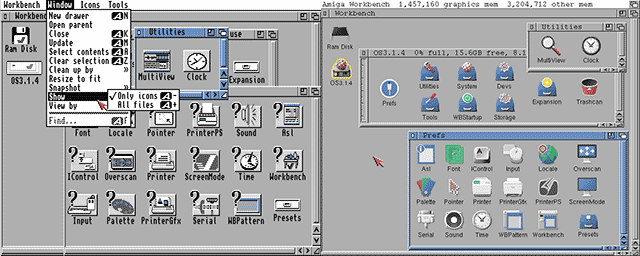
On the left is the default installation (4 colors) - Mason did create some new icons and after some copy commands it looks likt the picture on the right.
Already much better.
However ... the CD32 looks like this:
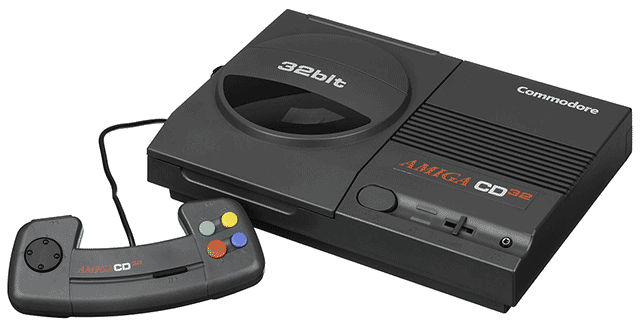
That mundane light gray and blue theme is really much too mundane for it's black and red looks.
The challenge is that this is a machine from 1993 and it's doesn't have the super fast graphic cards of today with millions of colors on 4K displays.
Allthough the Workbench can display up to 256 colors at the same time, that mode is too slow to be practical and it's more sane to only use 16 or 32 colors on a resolution of 640 on 480 pixels.
The even bigger challenge is that these colors are shared amongst all applications so each application has to adapt its colors to the ones available.
You can lock some colors (for examples for your icons) - and the other free colors can be free asigned - or battled for - by other applications.
So ...
I made a custom WorkBench theme - especially for the CD32.
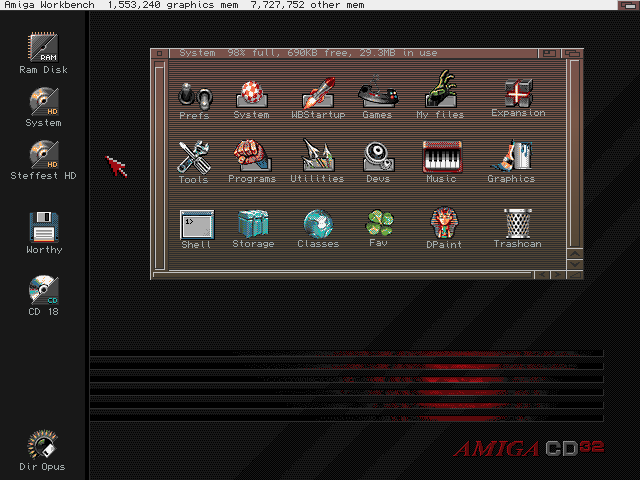
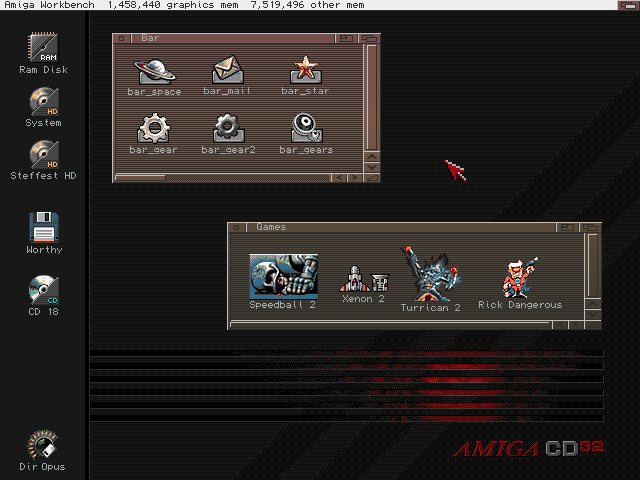
16 colors (and Copper Demon for the window gradients)
Made for square pixel screen modes (Pal hires laced e.g.)
This is the Palette:
![]()
Although it's possible to run this in a 16 color WorkBench, it's recommended to use at least a 32 color screenmode.
That way you can also set the MUI colors and still have some pens left for other programs.
Color Locker and Border Blanker recommended!
Workflow:
- First made in Photoshop,
- then color-reduced with (the super awesome) http://tool.anides.de/
- then cleaned up and re-dithered by hand back in Photoshop
- then cut out the icons and saved as NewIcons with Personal Paint on the Amiga
Everything is downloadable from here.
Some extra wallpapers and a description how to install are also there.
That was fun!
Steffest
Bassoon Tracker
Presenting a new project:
Bassoon Tracker!
It's a Browser based old-school Amiga Music Tracker in plain old javascript.
![]()
If you have ever heard of Protracker or Fasttracker, then you know the drill,
if not, then you are probably too young :-)
Check it out at http://www.stef.be/bassoontracker/
Tracker music originated way back in 1987 on the Amiga computer.
This was an era where PC's only made bleep sounds.
Even as the Atari could produce some funky chip sounds, then there was this all-singing-all-dancing Amiga machine that could produce 4 channel wave-audio.
Ok, it was still 8-bit sound, but suddenly everybody could access a digital music creation tool for an affordable price where previously you would have to spend a fortune on hardware samplers and midi interfaces to get the same possibilities.
My first sampler I soldered myself: You could plug it into the parallel port of the Amiga to "record" analog audio signals into 8-bit samples. It produced very low quality samples, but ohh... the wonder of it all!
It also was en era where user interface design was non existent so yes: the interface is a bit ... "special" :-)
![]()
Tracker programs where made by developers for developers: You don't enter notes on a musical bar, you enter notes as numbers in a grid with your computer keyboard and you apply effects by entering even more numbers.
All in hexadecimal of course, as plain decimal number are for pussies.
I especially like the format because you sort of get the sheet-music AND the instruments together with the song.
If you hear a cool piece and go like "Wow, how did they do that?" you can jump right in and examine what samples are used and what effects are applied.
It's like an open-source music format where you can do a "view source" to see exactly how it's done and fiddle with it, much as you can do with any website or web application.
Just like much of my early javascript and css knowledge was build by inspecting the source of other applications, much of my early musical knowledge was build inspecting mod files on the Amiga.
The golden age of the Amiga is long gone, but the tracker format lives on. There have been countless spin-offs and remakes.
Even in modern audio software like Renoise, Radium and Sunvox the tracker spirit is present.
And of course there's openMPT: It doesn't have a cool and snazzy interface but it's the most compatible and complete true tracker around.
Remember: these are not just mp3 files you hear, the music is reproduced using samples that are played and manipulated in sequence in real-time.
This is why mod files in general are quite small, making them perfect for (early) games and other projects where file size is important.
Even the super popular Unity game platform still has support for tracker formats
Playing mod files in a browser is nothing new, but still I wanted to create my own tracker for the following reasons:
- I wanted to research Web-Audio, especially real time audio manipulation.
- I wanted a real tracker where you can open, edit and save mod files, not just a player.
- It should perform well on mobile browsers.
Most mod players don't work that well on mobile browsers.
They tend to implement a very low level way of handling audio, doing the resampling and mixing all in the javascript layer, maybe because the code is ported or recompiled from other platforms.
I took a high-level Web-Audio approach which makes it perform really well on mobile browsers. Even if the UI slows down, the music should never stutter. - I wanted to build a SCALABLE cool retro user interface.
Most old-school trackers have a fixed size user interface.
I wanted a pixel-retro interface that scales with the screen.
You could call it "responsive design" but then for HTML canvas :-)
That's a pretty cool feature even if I say so myself! - I wanted to have a decent music playback engine to be able to build upon: a drum-sequencer? a midi-player? real-time online collaboration? all rather straightforward once the main playback engine is in place.
Anyway - here are some examples!
- Startdust Memories - By Jester
- Guitar Slinger - By Jogeir Liljedahl
- Space Debris - By Captain (Markus Kaarlonen)
- Title track of the game "Lotus Turbo Challenge 2"
- Professional Tracker - By H0ffman and DayTripper (Watch the pattern animation on this one)
Even more?
The ModArchive hosts thousands of tracker songs and they have an API so you can directly access them from within Bassoon Tracker.
The source files are available on GitHub.
Have fun, and if you think of any cool feature you're missing: let me know!
TV in Vlaanderen - Het land der blinden
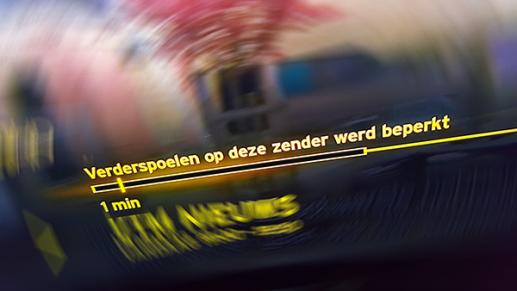
Hoe blind kun je zijn?
Erg blind, zo blijkt.
Peter Quaghebeur (Vroeger VTM baas en nu baas van SBS: Vier en Vijf) staat in het Vlaamse Parlement te jammeren dat de inkomsten van zijn bedrijf kelderen.
De Vlaming kijkt immers meer en meer "uitgesteld" en spoelt dan vlotjes de reclame door. hoe ongehoord!
Als er niets verandert is zijn bedrijf over 2 jaar dood.
Wacht wacht wacht, is dat diezelfde Peter Quaghebeur die vorig jaar tegen de uitgevers wereld "Pas je aan of sterf!" stond te roepen?
Ja dus!
Euhm ... ok ... pas je dan aan, hé!
SBS is een commercieel bedrijf.
Neem nu eender welk commercieel bedrijf dat zegt "Oei oei oei, mijn business model werkt niet meer, mijn klanten lusten mijn product niet meer waardoor mijn inkomsten dalen" Dan is het antwoord toch ALTIJD "ja, verzin dan iets anders wat je klanten wel lusten" ...
Als je product niet gesmaakt wordt, gaat je bedrijf op den duur kopje onder.
Dat is zo, en dat is goed, want dat zorgt voor innovatie.
Dat zorgt voor een constante drang - nee: verplichting - om jezelf steeds opnieuw in vraag te stellen en om je product te verbeteren.
Waarom staat die meneer Quaghebeur dan in het parlement te piepen?
Medialaan, die andere grote zuil, stelt als mogelijke oplossing "ondoorspoelbare advertenties" voor.
Dat is onder het motto van "oh ja, laten we ons product NOG irritanter maken, dat gaat vast goed werken"
Op dezelfde dag laat Netflix fijntjes weten dat ze 400 banen extra creëren in Amsterdam. Hun totale investering in Europese producties bedraagt al 1.75 mijard.
Dat gaat lekker blijkbaar, daar bij Netflix. En dat allemaal zonder reclame tussen hun aanbod!
Gebruikers betalen voor comfort, voor het wegnemen van wrijvingen en frustratie.
En dan komen ze met "ondoorspoelbare reclame" ... ja man ...#schud-meewarig-met-het-hoofd#
Ik denk dat wij een tamelijk doorsnee gezin zijn.
De kinderen kijken Netflix en Youtube - daar hebben ze meer dan genoeg aan.
De digicorder blijft meestal gewoon uit, nog af en toe een programma van Jani of Tom Waes; die zijn leuk.
Altijd uitgesteld, enkel de koers is live. (en het songfestival uiteraard!)
Nooit naar VTM, niet omdat het slechte programma's zijn maar omdat je daar bij Telenet de reclame niet kan doorspoelen als je uitgesteld kijkt.
Ja, er is VRT.nu en Stievie, maar dat is slechts met omwegen op het grote scherm te krijgen, veel te veel gedoe.
Wordt eens wakker, Peter, en doe je ogen open. Verwijt anderen niet in de tweede versnelling te blijven steken als je zelf niet veel hoger schakelt.
Dump desnoods Telenet en Proximus en ga rechtstreeks naar de klant, geef je klanten wat ze willen en als het lekker is betalen we daar voor.
Dump die reclameblokken en zoek andere manieren, desnoods via product placement in je programma's of via commerciele randactiviteiten.
Trek uitgesteld kijken op naar 1 maand, 1 jaar of eeuwig tegen extra betaling. Technisch is er geen enkele drempel.
Geef SD gratis weg en reken aan voor HD of 4K.
Er is een overaanbod aan entertainment.
Met een beetje moeite is alles gratis te vinden.
Nogmaals: gebruikers betalen voor comfort, het wegnemen van irritatie en een fijne, persoonlijke ervaring.
Een Vlaamse zender met goede content, zonder reclame, liefst met persoonlijke aanbevelingen in plaats van lineair, gemakkelijk consumeerbaar op elk scherm? Yep, daar wil ik gerust voor betalen. Laat maar weten als je mijn centen wil hebben.
Komaan man, je kan het!
Rag Dace
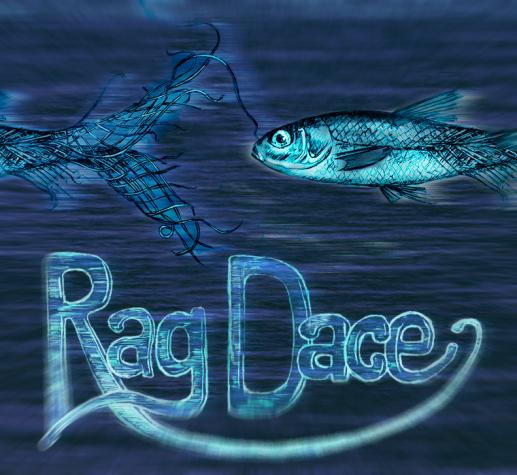
Na veel stoereventenpraat van "we zouden eens een bandje moeten beginnen" is het er van gekomen:
Rag Dace!
Bram mept op de drums en doet enthousiast.
Stef pluk wat aan de basgitaar en doet wat met knoppekes.
Zingen? Ja, dat ook hé, in het schoon Antwerps en al.
Wat we missen aan techniek en talent, maken we dubbel goed met speelplezier en de bijhorende Antwerpse charme.
En we geven zelfs ons eerste optreden: voor het goede doel!
In het kader van een ALS benefiet kunt ge naar onze kapriolen komen kijken en luisteren op vrijdagavond 21 april, Wolffaertshof Baron van Ertbornstraat 7, 2630 Aartselaar
Zie da ge op tijd zijt, want na ons komt de ECHTE band van de avond: The Armstrongs.
Wil je bij dit NU al legendarische optreden zijn?
Da kan hé mannekes:
Kaarten zijn hierzo te verkrijgen: https://www.facebook.com/events/589937384538592/ (of gewoon bij ons)
Alle opbrengsten gaan integraal naar het goede doel.
Zie daggeder zij!
Meer info op https://www.facebook.com/events/589937384538592/
Powertool Drag Racing
Op zondag 27 november deden we mee met het Belgisch Kampioenschap Powertool dragracing.
Ow Yeah!
Het concept is simpel: Je neemt een elektrisch handgereedschap en je vormt dat om tot iets dat zich kan voortbewegen. Je hebt een baan van 20 meter en een start/stop knop. Je racet met 2 tegen elkaar en wie als eerste de finish bereikt is gewonnen.
What can possibly go wrong? :-)
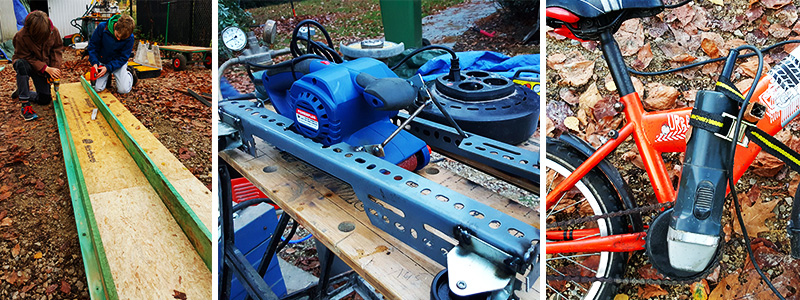
We begonnen met een bandschuurmachine. Dat schiet al aardig vooruit als je dat niet vasthoudt, maar is ook wel wat saai en voor de hand liggend. Dat kan beter!
Een oud kinderfietsje met in plaats van trappers een stevige slijpschijf. Dat werkt, maar de motor van de slijpschijf levert duidelijk veel te weinig vermogen: na een paar meter smeult de plastic behuizing er net niet af.
Daar dienen tandwielen voor natuurlijk!
Wegens gebrek aan reuze-fietstandwielen tekenen we een T78 tandwiel (met 78 tanden dus) en nog een paar kleintjes.
Bram heeft connecties en kan het rap laten uitlaseren uit 3mm staalplaat. Handig, zo'n Bram-gerief in de buurt.
Wat mep- , slijp- en laswerken verder is ons Frankenstein geval klaar.
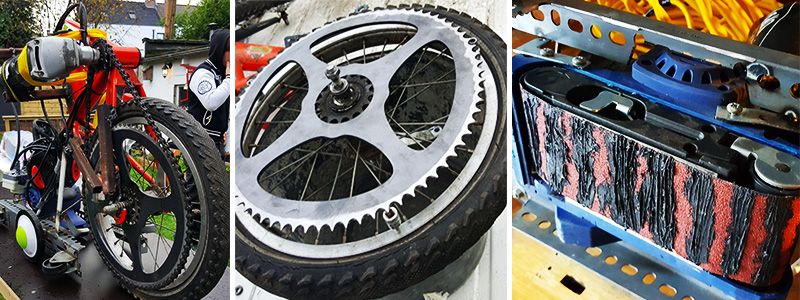
Racen!
Van de 19 ingeschreven ploegen verschijnen er 16 met een rijdklaar vehikel aan de start.
Goed om te zien dat de funfactor en teamspirit overheerst.
ATV en de VRT zijn present, de kinderen worden geïnterviewed door Karrewiet. Plezant.
Na een paar gewonnen races komen we onze meerderen tegen en begint ons ding ook al wat uit elkaar te vallen.
De rubberen groeven van de schuurband zijn spiegelglad geworden, ons steunwieltje is door de wrijvingshitte vastgesmolten aan zijn as en door een iets te harde botsing met de finish breekt uiteindelijk de as van de slijpschijf af.
Toch een 5de plek. Niet slecht!
De overwinning gaat uiteindelijk terecht naar het dodelijk efficiënte "Atelier Vilvoorde".
Mijn persoonlijke favoriet is toch wel team "LaDa" die alles ge-3D-print en uitgelasered hebben. Schoon gerief, maar door de harde finish-botsingen breken hun verbindingen en grondplaat door en stranden ze in de finale.
Yep! Dat was een plezant projectje met plezante vrienden en zonen - dat mag nog!
Dikke merci aan Anthony voor de organisatie.
Physical buttons for your Sonos
I totally love my Sonos system.
The Sonos players are expensive but they are worth every penny and i haven't regretted any of my Sonos purchases for a minute.
There's one thing missing though ... hardware buttons!
Even as a smartphone or tablet to control your appliances is perfect (remember 2009?), sometimes you just don't have your smartphone ready at hand and you find yourself hunting for your smartphone to control your Sonos.
Yes, each Sonos has some hardware buttons, but they are only used to play/pause the current song, or to adjust the volume of that particular player.
Enter D.I.Y.
I'm a big fan of old tube-based radio's. If they are not too far gone they get repaired, otherwise they just look cool.
One particular little radio-bugger was beyond salvation and received another purpose: controlling the Sonos with some presets, volume and play/pause with its old-school tactile click-clack buttons.
The final contraption looks like this: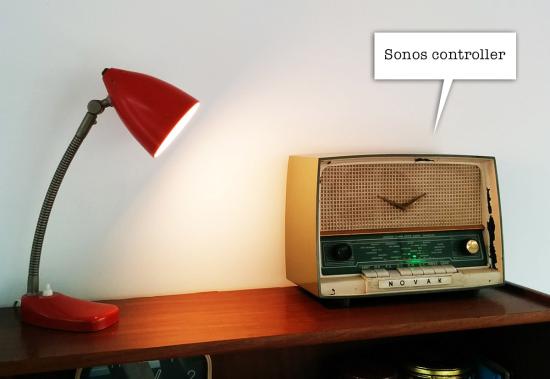
very incognito. looks like a radio, no?
On the inside the buttons are wired to a little Arduino.
When you press a button or turn the volume knob, one of the digital or analog inputs of the Arduino is activated, allowing you to define a resulting action in software.
There's a little WiShield attached to the Arduino allowing it to communicate over wifi with other devices.
Although it's possible to talk to the Sonos devices directly using the UPnP protocol, it's easier to use a some sort of middleware like the excellent Sonos Http Client by Jimmy Shimizu .
The WiShield is rather old in terms of IT-gadget-age and its libraries are not compatible with the current generation of Arduino IDE.
I had to patch them a little to make them work on Arduino 1.x and up. You can find my fork here.
The little Arduino sketch that controls everything is also on my GitHub.
A little status led completes the setup, giving some feedback on your actions.

With the radio buttons i can now activate the 5 presets we use the most, change the volume of the grouped sonos speakers and pause/play everything.
The presets are currently 3 radio stations (Studio Brussel, Radio 1, Radio Nostalgie), the Spotify favourite list (starred tracks) and a random Spotify playlist.
Due to some wonderful coincident the labels of the buttons also EXACTLY match the preset they trigger:
How convenient!
The concept is a bit hard to explain to people who don't have a wireless speaker system.
Most of the time they just stare blankly and go
"Uhm ... so you've build a radio that you can use to ehm ... turn on the radio? ... Ok ... cool ..."
Exactly!
Just like software controllers as Ableton Live end up up creating matching hardware controllers with LOTS of buttons, let's hope this is the start of a trend.
There's nothing like the feeling of pressing a big chunky button down and make it go *CLACK* , far more satisfying than using the non-tactile buttons of a touchscreen controller ... .
Hmm, I still have this thing somewhere in my garage ... what still needs controlling?
Tags: Arduino, in English, Programming, TinkeringGeef je reactie (3)
Stieviewtniemier
Flauw zenne ...
Het was natuurlijk te verwachten maar de naïeveling in mij blijft natuurlijk denken dat moderne mediabedrijven iets van community communicatie afweten.
Niet dus.
Vandaag een officiële ingebreke stelling in de bus i.v.m. de stieviewer.
Het volledig document is hier te vinden.
Het is natuurlijk hun volste recht om de pedante bullebak uit te hangen.
Jammer dat ze dergelijke initiatieven vanuit hun eigen gebruikersgroep zo aanpakken.
Afin - whatever.
Ik ben natuurlijk nen doodbrave mens en heb netjes de Github repository offline gehaald.
(En dan had ik mijn Stievie-recorder nog niet eens gereleased :-) )
Mijn Stievie account is trouwens niet geblokkeerd.
Die 10 euro per maand ... die willen ze dan weer wel!
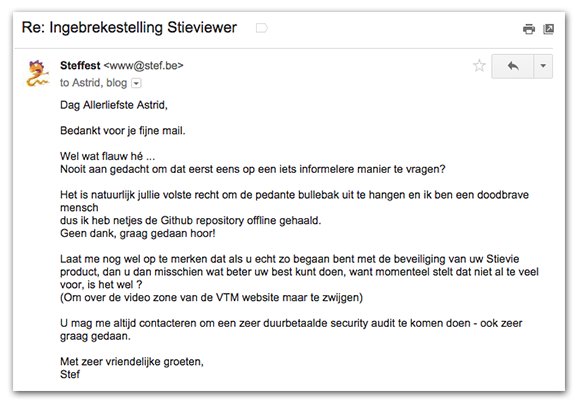
Stievie kijken op je PC en op XBMC/Kodi
Stievie is best lollig.
Het is natuurlijk ook veel te duur en bevat veel te veel gaten in de programmagids, maar als concept is het prima.
Jammer alleen dat je perse een tablet of telefoon moet gebruiken en dat je het niet met XBMC/Kodi kunt gebruiken.
Dat zal best 1 of andere rare prehistorisch reden hebben, maar zuiver technisch zal die reden niet zijn.
Ik hou niet zo van apps, zo van die dichtgesmeerde gepolijste bolletjes waar je enkel datgene mee kunt wat de appmaker wil dat je kan.
Waarom kan niet gewoon alles wat meer open en flexibel zijn zodat je het beter kunt afstemmen op je eigen wensen?
Natuurlijk kan dat wel!
Enter de Stie-viewer: een webapplicatie die je lokaal draait en waarmee je alle programma's die op Stievie staan gewoon in je browser kunt bekijken.
Als extraatje zit er een kleine XBMC/Kodi component in waarmee je een programma ook op XBMC/Kodi kunt afspelen.
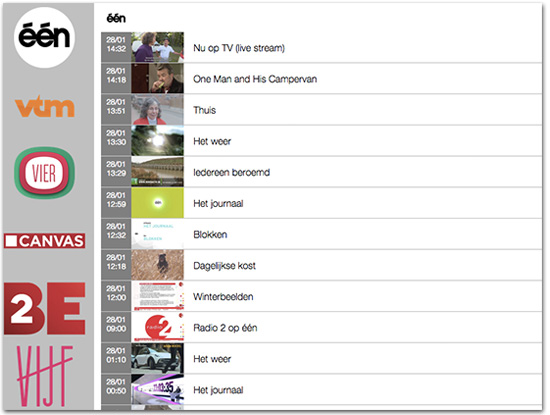
Je vindt het op https://github.com/steffest/Stieviewer
Het is dus NIET iets waarmee je zomaar de Stievie beveiliging kunt omzeilen:
- Je hebt nog steeds een geldige Stievie account nodig
- Je kan nog steeds niet op meer dan 1 toestel tegelijk kijken
- Je kan geen programma's bekijken die niet op Stievie beschikbaar zijn (die uitgegrijsd zijn of meer dan 7 dagen oud zijn)
Kortom: Bekijk het als een onschuldig scriptje dat Stievie iets aantrekkelijker maakt, niet als iets dat bedoeld is om Stievie te ondermijnen.
(Met andere woorden: don't sue me, i'm not attacking your product, just presenting some added value :-) )
De installatie is wat geeky: je hebt node.js nodig. Als je dat nog niet geinstalleerd hebt, vind je dat op http://nodejs.org/
Download de applicatie via https://github.com/steffest/Stieviewer - ga via de command line naar de plaats waar je het uit hebt gepakt en type
npm install
daarna kun je het starten via
node server.js
en is de applicatie beschikbaar via http://localhost:8000 in je browser.
De eerste keer dat je de Stieviewer opent dien je een geldige Stievie login in te vullen.
Je login wordt niet opgeslagen.
Ze wordt enkel gebruikt om de Stievie authenticatie server te conctacteren.
Daarna krijg je een access token die in je local storage wordt bewaard.
Je kan dan alle zenders doorbladeren en het programma in je browser bekijken. Vermits de meeste browser het video formaat van Stievie niet gebruiken, wordt er op de meeste browsers een flash-fallback gebruikt om de video af te spelen.
Je kan natuurlijk ook de url van de video stream kopiëren en bv. afspelen in VLC of QuickTime.
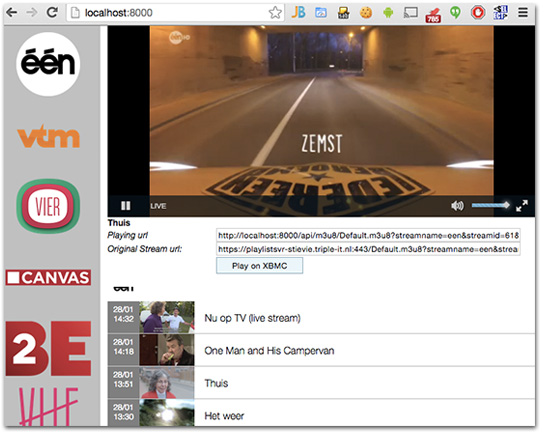
Wil je het programma via XBMC/Kodi bekijken dan klik je op "Play on XBMC".
Kijk dan wel eerst even na dat je de http interface van XBMC hebt aanstaan.
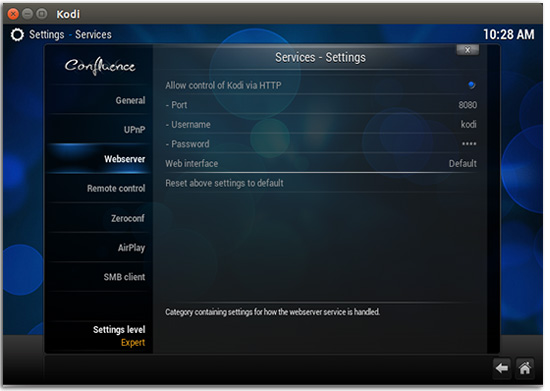
Je vult het ip adres en poort van XBMC in, samen met je login en paswoord en klikt op "Send".
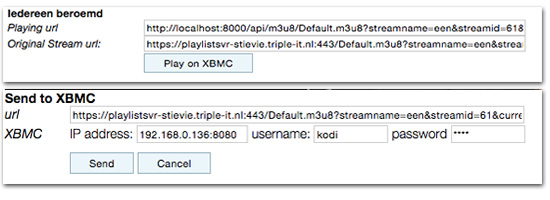
Daarna heb je je PC niet meer nodig: XBMC speelt rechtstreeks de video af vanuit Stievie.
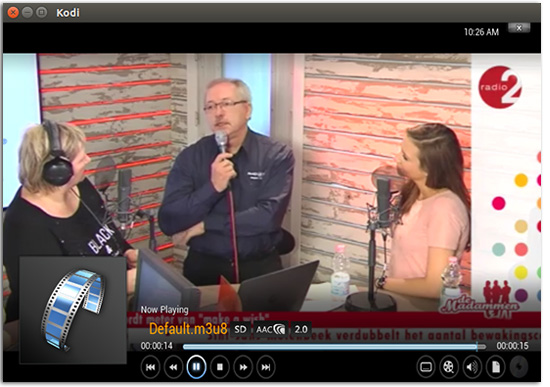
Hoe werkt het?
Je start via Node een lokale webserver op.
Deze doet zich voor als echte "Stievie App" en communiceert met de Stievie server om alle gegevens op te halen.
Daarna verpakt de applicatie deze gegevens een beetje anders zodat je er iets mee kunt doen in een webbrowser.
Om de video af te spelen wordt (meestal) Flash gebruikt.
Om de Same-Origin restricties van een webapplicatie te omzeilen wordt alles via de lokale webserver gesluisd zodat Flash de video kan afspelen.
XBMC/Kodi kan (sinds kort) ook Http Live Streaming videos afspelen, maar heeft blijkbaar nog wat moeite met Adaptive Streaming.
Daarom wordt er op het moment dat je iets naar XBMC stuurt eerst de HLS index playlist opgevraagd en wordt de eerste "echte" playlist die daarin staat naar XBMC gestuurd ipv. de adaptive playlist.
Meer info en de volledige broncode vindt je op https://github.com/steffest/Stieviewer
Het is nog wat ruw en niet echt bedoeld als gepolijst product voor de eindgebruiker, maar toch al bruikbaar.
De Stieviewer is op geen enkele manier gerelateerd met Stievie, Medialaan en/of Triple-IT.
Enjoy and be nice!
Airwave Pong Style!
Wave you hands in the air and pong it like you just don't care!
I like old stuff: it has a story, it is used. it has flaws.
And exactly those imperfections are interesting. Waba-Sabi you know?
That's why I ditched all my CD's and moved back to Vinyl,
and that's also why In my opinion most "pre-computer music" sounds better.
When you take a basic step sequencer or midi program, it's a robot: all notes are aligned on a fixed grid and it usually takes some effort to get a "human feel" to your music.

Now what if you could ease it up a bit in a fun way?
Let's take the graphical representation of a "beat" in most common step sequencers.
and let's take this thought one step further: the graphical representation defines the music, right?
So what if we alter the graphics, would the music change too?
For example, if we want to add a fade, we can just as well use photoshop to add some blur, right?

And if we want to loosen up that fixed grid, why not use a graphical filter to make it more "wobbly"

This way we can use graphical tools to mold your music into a more organic shape.
And more!
What if we could "read" any image in a musical way?
An image consists of lot's of coloured dots, each dot has some info we can use. on a computer screen, this is for example the amount of red, green and blue and the transparency.
We can sample that info from an image and use it for something musical.
An example: move you mouse over this image of a jungle, to explore it in an audio-way. (Well ... after you click on it to open the demo, right?)
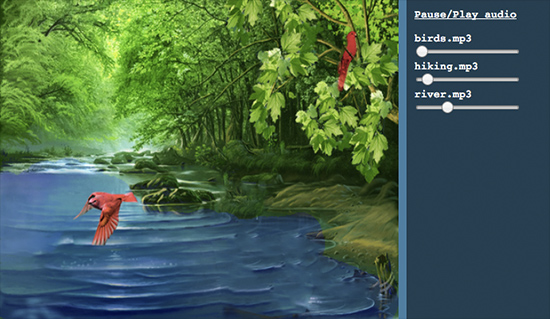
To pour that into something musical, we can use "the bouncing ball" effect: a ball bouncing around in a rectangular box has 2 rhythms that are both fixed but as the sides of the box are not equal, the rhythms are constantly shifting.
It has the predicable structure of a beat box, but also the unpredictability of 2 patterns intermingling: Exactly the interesting effect we are looking for.
Try it out for yourselves!
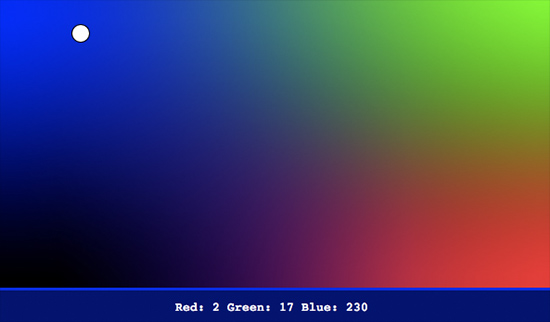
(Seriously: leave it running on chrome or safari for a few hours: it's very relaxing!)
Of course we don't have to use a static image, we can use a video or ... a camera!
That is when things really get interesting: when you connect a camera as your graphical/musical input source, you can interact with your musical model live, in front of your camera.
Add a little motion-tracking and color-tracking, and you get a pretty accurate way of triggering musical events using your webcam.
To go all the way back to music software, we can even add some MIDI to trigger midi events using your webcam, and to record everything you do in your midi sequencer to take it further along towards a full musical production.
Wham! Before you know it, you got yourself a playful musical instrument.
Of course, it's a bit hard to control. It's probably wise to limit yourself with some quantization or some predefined chord schematics to get the sound you want.
Fiddling around with all my prototype toys, I created this demo song - I call it "Airwave pong" (You now: Wave you hands in the air in front of your webcam - combined with pong)
To be honest, I had to do a lot of post-processing on the midi data ... my motion tracking routines are somewhat crude and fly all over the place.
If you want to try it out for yourself, come find me a Barcamp Antwerp 7 this saturday, where I will be doing a live demo and will release all the tools I used.
Yes indeed: barcamp STILL is one of the most inspiring events EVER.
The concept is simple: short and open talks about anything you're passionate about.
The presentations won't be perfect, but they will be real and honest, which makes them far more valuable then about 90% of al other talks on "professional" events.
So if you happen to be in the vicinity of Antwerp, do yourself a favour and drop by #BCA7
I can't wait !

Foto door Simon Schoeters
Tags: Graphics, in English, Music, Programming, Tinkering, VideoGeef je reactie (1)Leave a light on
Schoon, die "Leave a Light On" van Marble Sounds.
Voor diegene die - net zoals ciska - goesting hebben om hun mooiste zangstem boven te halen en er een warme kerstversie van te brengen maakte ik er een instrumentale meezing versie van.
Ik zocht eigenlijk vooral een testprojectje om de nieuwe versie van Ableton Live eens uit te proberen.
Goe gerief, diene Live.
Hier is het midi bestand mocht je er zelf mee verder willen prutsen.
Als je Ableton Live gebruikt is hier het Live bestand
(en ook: koop hun album ! )
Voor de volledigheid hier de songtekst:
Sure I can leave a light on
Let it shine on
Leave it till dawn
Sure I can leave a light on
Leave a light on for you
It takes two to find a way out
There is no doubt
I will be around
If you have lost the right track
Then I'll lead you right back
Don't search to find
Don't smile just to be nice
Don't run just to get there on time
Be amazed
Simply blown away
Live on without
Getting off your cloud
Sure I can leave a light on
Leave a light on for you
Sure I can play a quiet song
I could just hum
Beat a soft drum
Sure I can play a quiet song
Play a quiet song for you
It takes you to make my heart sing
To let air in
And keep breathing
It takes two to keep the vibe true
I am waiting for you
It struck me again
We both look the same
But what you make
Appears in all shapes
I should impress
But nevertheless
I cannot change
Night into a day
So sure I can leave a light on
Leave a light on for you
© 2013 Marble Sounds/Zealrecords
Original song: Leave a Light on - Marble Sounds

